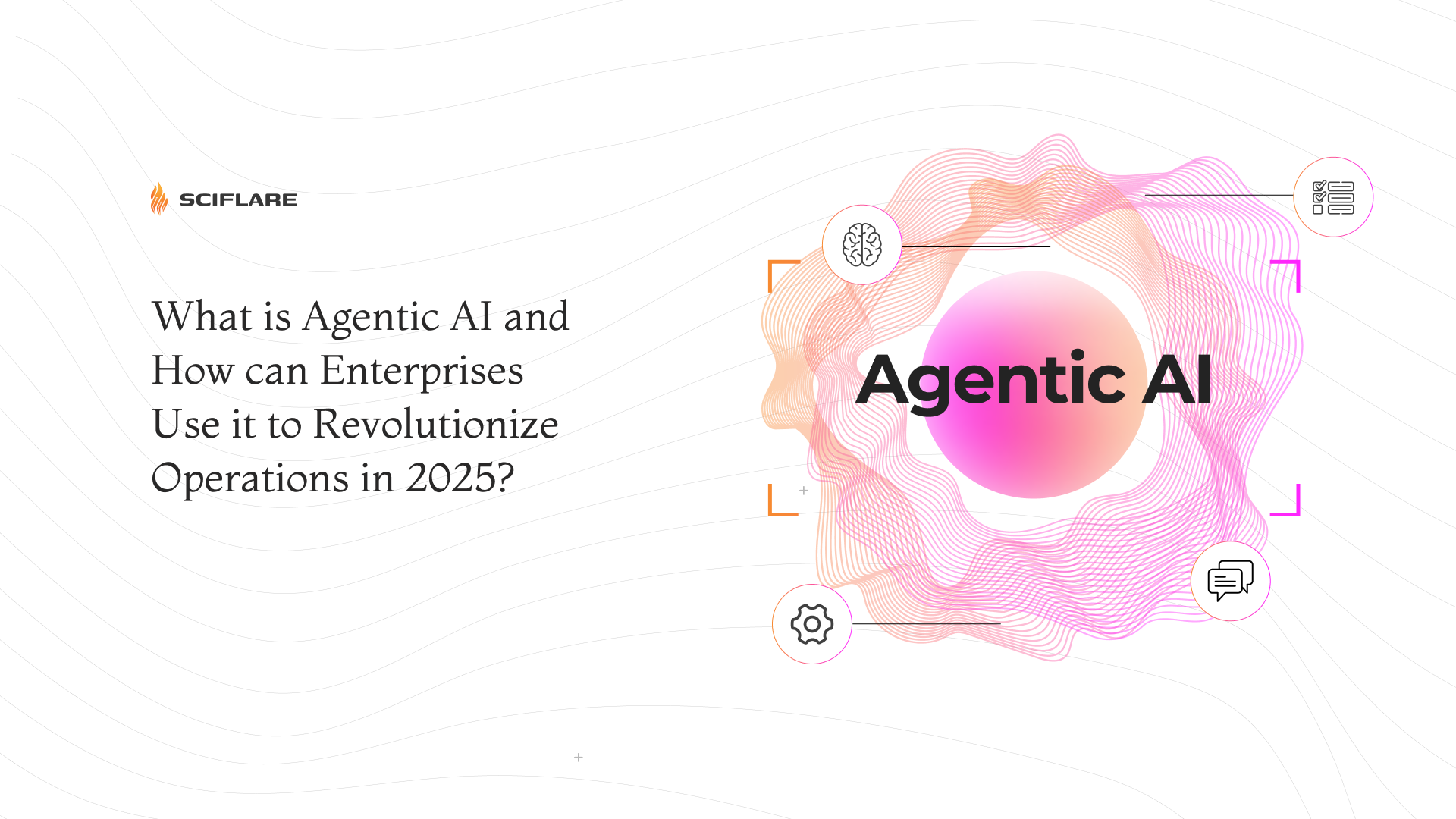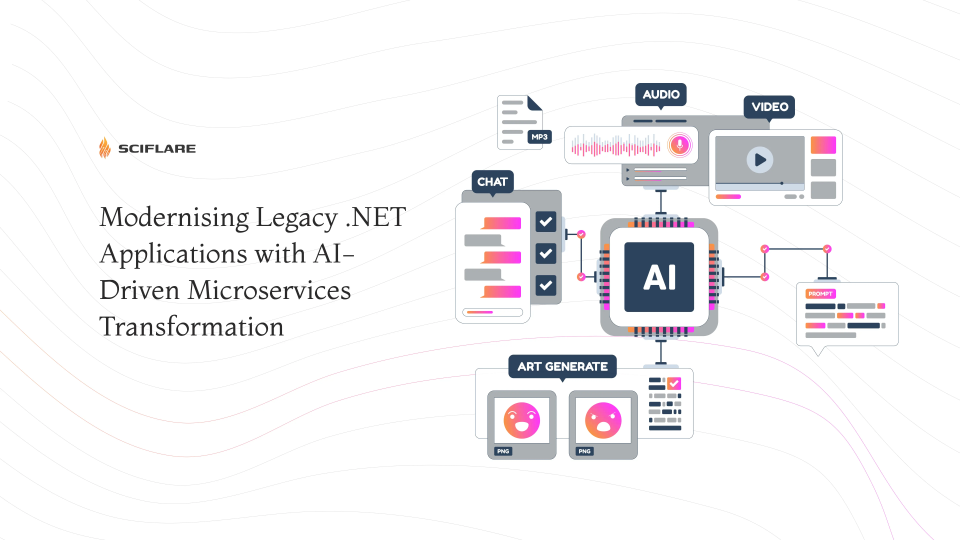
From Legacy .NET to AI-Ready: Microservices for Scalable Transformation
Written by: Shiva kumaran S
Introduction
Many enterprises still operate on legacy .NET frameworks and tightly coupled monolithic architectures. While these systems may continue to function, they often slow down innovation, increase maintenance overhead, and block scalability. Modern user expectations, growing data volumes, and AI-powered automation demand more flexible, modular, and intelligent systems.
This is where Sciflare steps in as a modernization partner—helping CTOs, CIOs, and Engineering Heads re-architect legacy .NET applications into AI-ready, microservices-based systems. This transformation unlocks speed, agility, and business insights that monolithic platforms cannot match.
Why Legacy .NET Applications Block AI Readiness
Enterprises running applications on legacy .NET frameworks (e.g., .NET Framework 4.x) face several barriers to modernization:
Tightly coupled architecture makes updates and scaling risky and time-consuming.
Limited support for modern integrations like REST APIs, cloud-native deployments, and AI engines.
Long release cycles due to shared dependencies and lack of automation.
Inefficient data pipelines that block real-time processing needed for AI.
These challenges not only impact developer productivity but also limit the enterprise’s ability to experiment with AI models, automation tools, or analytics engines that need microservice-level agility.
In many cases, legacy systems were not built with today’s dynamic and distributed digital environment in mind. They struggle to integrate with AI/ML workflows, real-time data streams, and cross-platform functionality. This becomes a major roadblock for product managers and IT decision-makers looking to roll out AI-enabled features such as intelligent search, NLP, fraud detection, or demand forecasting.
Additionally, legacy systems may rely on outdated security mechanisms, making them vulnerable in today’s threat landscape. They may also depend on unsupported libraries or frameworks, creating compliance risks and operational bottlenecks.
Microservices as the Backbone of Modern Transformation
Decoupling legacy .NET applications into microservices lays the groundwork for intelligent automation and future-ready scalability.
Scalability and Modularity Advantages
Each microservice is independently deployable and scalable.
System failures are isolated, reducing downtime risks.
Easier integration with containers (Docker), orchestration platforms (Kubernetes), and CI/CD pipelines.
Facilitates cloud-native modernization (AWS, Azure, GCP).
This modular structure also enables teams to isolate business domains—such as billing, authentication, or user management—and allocate ownership more clearly. This enhances security, performance tuning, and feature-specific innovation.
Faster Innovation and Continuous Delivery
Independent teams can work on different services without dependency conflicts.
Frequent deployments with minimal disruption.
Simplifies A/B testing, feature flags, and rollback strategies.
Enables DevOps and agile practices end-to-end.
With microservices, enterprises can experiment more confidently and release updates faster, making it easier to respond to market demands, customer feedback, or business pivots.
Moreover, the adoption of Infrastructure-as-Code (IaC) tools and GitOps methodologies becomes seamless in microservices environments, driving speed and standardization across deployments.
How AI Enhances Modernisation of Legacy Apps
AI is not just a post-modernization add-on; it accelerates and enhances the modernization journey:
AI-assisted code analysis helps identify legacy components, redundant code, and modernization opportunities.
Automated testing using ML models speeds up regression testing and bug detection.
Predictive autoscaling adjusts cloud resources dynamically based on user load.
AI-powered observability provides real-time anomaly detection in production.
In addition to this, AI tools can generate code migration suggestions, validate code quality at scale, and automate routine maintenance tasks. AI-driven DevOps pipelines can prioritize high-impact changes, monitor technical debt, and even simulate post-migration performance scenarios. These efficiencies reduce risks during modernization and improve outcomes.
Intelligent chatbots and AI service layers can also be integrated into modernized apps to enhance end-user experience, personalize workflows, and support real-time decision-making.
Business Outcomes of AI-Driven .NET Modernisation
Enterprises that modernize with Sciflare’s AI-centric microservices architecture can expect tangible business outcomes:
50% faster release cycles through modular development and automated testing.
Up to 40% reduction in infrastructure costs via cloud-native and autoscaling systems.
Enhanced reliability and uptime, even during peak traffic.
Real-time insights through intelligent analytics layers.
Increased development velocity, allowing faster experimentation and rollouts.
A modern, AI-ready stack also makes it easier to onboard new developers, adopt DevSecOps principles, and integrate third-party APIs or SaaS platforms that require real-time data exchange.
Organizations can also unlock new revenue streams by offering API-based services or enabling integrations with partners, suppliers, or customers. Modernization can thus turn IT infrastructure into a business enabler, not just a cost center.
Mini Case Study
A leading SaaS provider modernized its legacy .NET platform using an AI-driven microservices architecture. Event-driven concurrency enabled 500K+ requests per minute with sub-50 ms response time and zero downtime during high-traffic periods. This architecture improved release agility and enabled real-time analytics for decision-making.
Another Sciflare client, a financial services enterprise, leveraged AI-driven modernization to automate loan approvals. By decoupling their .NET monolith into microservices and integrating an AI decision engine, they reduced approval time by 80% and improved compliance tracking.
Preparing for the Future with AI-Ready IT Infrastructure
Sciflare’s phased approach ensures zero disruption and maximum ROI during modernization:
Assessment: Evaluate the existing legacy .NET architecture, data dependencies, and modernization scope.
Architecture Blueprinting: Design a domain-driven microservices architecture aligned with business workflows.
Automation Implementation: Integrate AI-assisted development, automated testing, and CI/CD pipelines.
Cloud-Native Deployment: Containerize microservices and deploy on scalable cloud infrastructure.
Operational Monitoring: Implement AI-powered observability and monitoring tools for ongoing performance and reliability.
Feedback Loop Integration: Enable systems to learn from user behavior and operational data to drive further optimization.
Governance & Security: Establish enterprise-wide controls for API security, identity management, and compliance.
Sciflare supports enterprises at each stage with expert consultants, engineers, and AI specialists to deliver successful outcomes.
Conclusion
Modernizing legacy .NET systems with AI-driven microservices isn’t just a technical upgrade—it’s a business enabler. It unlocks speed, agility, scalability, and insight for today’s digital enterprises.
By combining architectural best practices with automation and AI, enterprises can gain a competitive edge, reduce technical debt, and respond to market shifts with confidence.
Whether you’re a CTO planning digital transformation, or an IT leader seeking better performance from your legacy assets, Sciflare offers a proven roadmap for modernization.
Talk to our experts to plan your AI-ready modernization roadmap.
FAQs
1\. What are the benefits of microservices for legacy .NET applications?
Microservices improve modularity, scalability, and fault isolation. They also facilitate faster deployment and easier integration with modern tools and platforms.
2\. How can AI assist in software modernization?
AI helps with legacy code analysis, test automation, predictive scaling, and anomaly detection, enabling faster and smarter modernization.
3\. What’s the safest path for migrating monolithic .NET apps?
Start with assessment, move to microservices design, automate testing and deployment, then gradually replace components with minimal disruption.
4\. How long does AI-driven modernization typically take?
Timelines vary based on system complexity, but phased transformation with MVP delivery can begin showing results within 3–6 months.
5\. Can we modernize without rewriting the entire application?
Yes. Using techniques like strangler pattern, containerization, and API gateways, legacy apps can be incrementally modernized with minimal rework and zero downtime.
6\. How do I justify modernization to business leadership?
Highlight faster time-to-market, reduced operational cost, improved security, and the ability to deliver AI-powered features that drive competitive differentiation.




